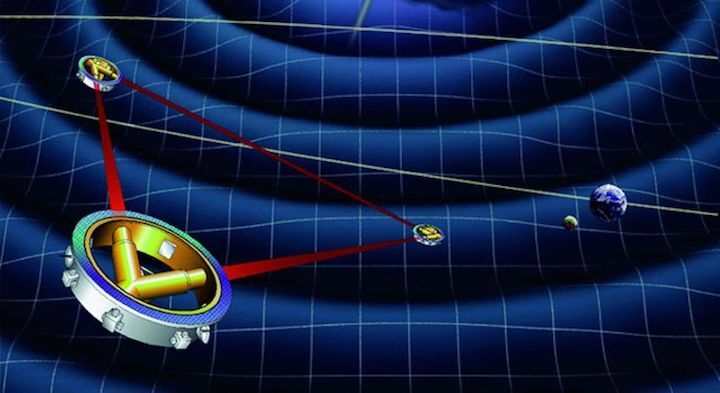The first space-based observatory designed to detect gravitational waves has passed a major review and will proceed to the construction of flight hardware. On Jan. 25, ESA (European Space Agency), announced the formal adoption of LISA, the Laser Interferometer Space Antenna, to its mission lineup, with launch slated for the mid-2030s. ESA leads the mission, with NASA serving as a collaborative partner.
29.01.2018
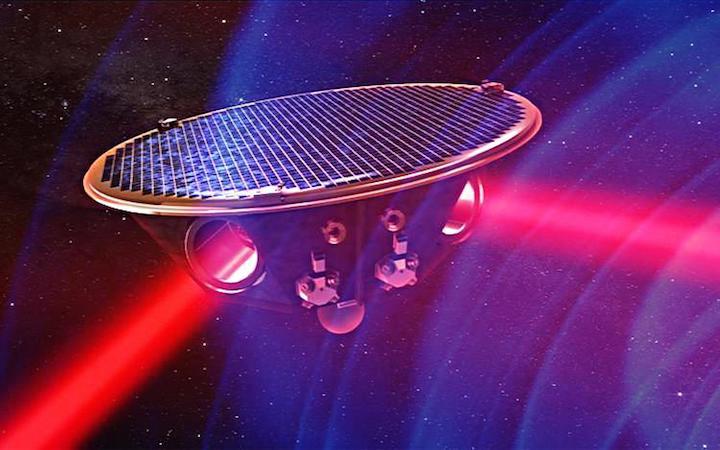
LISA mission passes review successfully and begins next stage of development
LISA has passed its Mission Definition Review with flying colours
-
The MDR's goal is to review and confirm that
- LISA's present mission design is feasible and suitable,
- the mission requirements meet LISA´s science requirements,
- the requirements are mature and adequate to the current phase,
- the technology developments are adequate to the current phase, and
- the interfaces between spacecraft, payload ground segment and launcher are well defined.
“I am very satisfied that LISA passed the assessment so well. Now we are heading to the next phase. 2018 will be filled with further examinations, investigations and technology development. It’s great to see LISA making so much progress,” says Prof. Dr. Karsten Danzmann, director at the Max Planck Institute for Gravitational Physics (Albert Einstein Institute), director of the Institute for Gravitational Physics at Leibniz Universität Hannover, and LISA Consortium Lead.
LISA is scheduled for launch into space in 2034 as a mission of the European Space Agency (ESA). It is supported by many ESA member states as well as NASA and many scientists working together across the Atlantic. LISA will consist of three satellites spanning an equilateral triangle with each side approx. 2.5 million kilometres long. Gravitational waves passing through the constellation change these distances by a fraction of the diameter of an atom. LISA's key technologies were successfully demonstrated with ESA's LISA Pathfinder mission, which operated from late 2015 until mid 2017.
LISA will measure low-frequency gravitational waves with oscillation periods ranging from 10 seconds to more than half a day, which cannot be detected with detectors on the earth. These are emitted by events such as supermassive black holes with millions of times the mass of our Sun merging at the centres of galaxies, the orbital motions of tens of thousands of binary stars in our Galaxy, and possibly exotic sources such as cosmic strings.
+++
Nach erfolgreicher Überprüfung beginnt für die LISA-Mission die nächste Entwicklungsstufe
LISA hat ihre Mission Definition Review (MDR) mit Bravour bestanden
-
Ziel des MDR war, zu überprüfen und zu bestätigen, dass
- das Design der LISA-Mission zweckmäßig und für die wissenschaftlichen Ziele geeignet ist,
- die technologischen und wissenschaftlichen Anforderungen aufeinander abgestimmt sind,
- die Anforderungen ausgereift sind und der aktuellen Entwicklungsphase entsprechen,
- die Technologieentwicklungen der aktuellen Phase angemessen sind und
- die Schnittstellen zwischen Raumfahrzeug, Nutzlast, Bodensegment und Trägerrakete klar definiert sind.
„Ich bin sehr zufrieden, dass LISA die Überprüfung so gut bestanden hat und große Fortschritte macht. Jetzt gehen wir in die nächste Phase. 2018 stehen zahlreiche weitere Untersuchungenund die Entwicklung und Anpassung von Technologien an“, sagt Prof. Dr. Karsten Danzmann, Direktor am Max-Planck-Institut für Gravitationsphysik (Albert Einstein-Institut), Direktor des Instituts für Gravitationsphysik der Leibniz Universität Hannover und Leiter des LISA-Konsortiums.
LISA soll 2034 als Mission der Europäischen Weltraumorganisation (ESA) ins All starten. Unterstützt wird die Mission von vielen ESA-Mitgliedsstaaten, der NASA und zahlreichen Wissenschaftler*innen in einer engen transatlantischen Zusammenarbeit. LISA wird aus drei Satelliten bestehen, die mit Lasern ein gleichseitiges Dreieck mit ca. 2,5 Millionen Kilometern Kantenlänge aufspannen. Durch diesen Formationsflug im All laufende Gravitationswellen verändern diese Abstände um einen Bruchteil des Durchmessers eines Atoms. LISAs Schlüsseltechnologien wurden Ende 2015 bis Mitte 2017 erfolgreich mit der LISA Pathfinder-Mission der ESA demonstriert.
LISA wird niederfrequente Gravitationswellen mit Schwingungsperioden von 10 Sekunden bis zu mehr als einem halben Tag messen, die mit Detektoren auf der Erde nicht beobachtet werden können. Solche Gravitationswellen stammen beispielsweise von
- extrem massereichen Schwarzen Löchern, millionenfach schwerer als unsere Sonne, die im Zentrum von Galaxien verschmelzen.
- den Bahnbewegungen zehntausender Doppelsternsysteme unserer Galaxie stammen
- und möglicherweise exotischen Quellen wie kosmischen Strings.
Quelle: Albert-Einstein-Institut in Hannover
---
Update: 1.02.2018
.
LISA Pathfinder
Paving the way
Pushing physics to the limit: Airbus Defence and Space engineers have designed and built the spacecraft and instruments for LISA Pathfinder, the technology demonstrator mission of one of the most ambitious scientific undertakings to date: proving key elements of Einstein’s theory of general relativity.
The whole point is to show that the technological concepts developed for the detection of gravitational waves in space actually work.
Ian Honstvet, LISA Pathfinder Project Manager
LISA Pathfinder is a unique European Space Agency (ESA) mission, requiring engineering that has never been done before. As Airbus Defence and Space UK is prime contractor, engineers in Stevenage were responsible for designing and building the overall system and platform. The Drag-Free Attitude Control System (DFACS) was developed in Friedrichshafen, as was the LISA Technology Package (LTP) under a separate ESA and DLR contract.
Together, they have created a spacecraft able to manage its own gravitational, magnetic and thermal environment, so that two test masses – identical gold and platinum cubes – follow a perfect inertial path within a delicate instrument, shielded from all disturbances except gravity. To achieve this, the spacecraft does not just transport the payload to its destination, but becomes part of the experiment itself, forming a single unit.
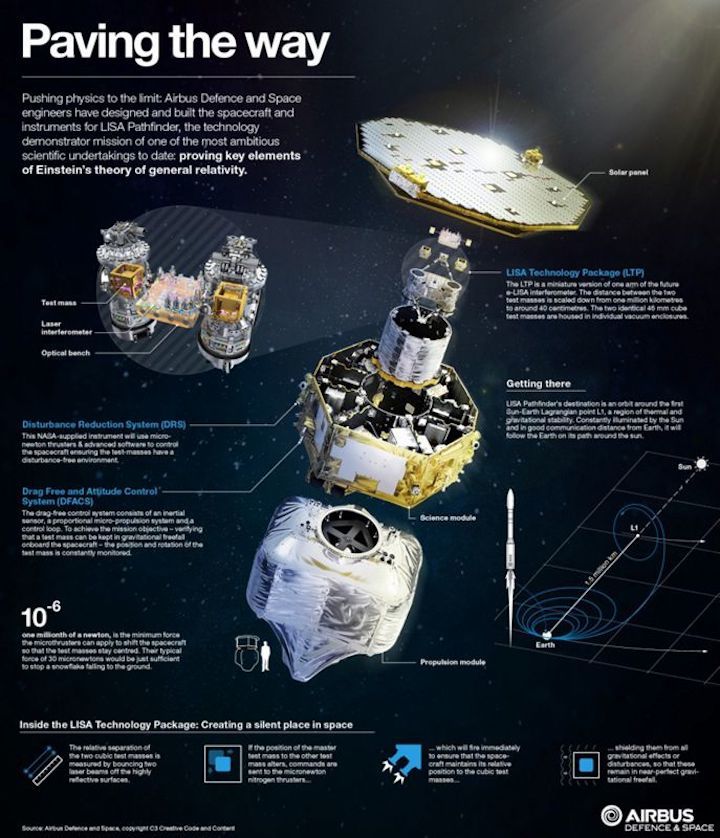
The challenge is immense as, even in space, there are many other forces at play apart from gravity, including radiation pressure from sunlight, charged particles from solar wind and tiny micrometeoroids impacting the spacecraft.
LISA Pathfinder‘s destination is an orbit around the first Sun-Earth Lagrangian point L1, a region of thermal and gravitational stability. Constantly illuminated by the Sun and in good communication distance from Earth, it will follow the Earth on its path around the sun.
If LISA Pathfinder is as successful as is hoped, the mission will have paved the way for the actual experiment, LISA. This ambitious mission, planned for 2035, will send a cluster of three spacecraft into space to replicate the experiment on a much larger scale. Each containing a free-flying test mass, the spacecraft will form an equilateral triangle with side lengths of about one million kilometres, creating the largest man-made structure ever in space. Precise heterodyne laser interferometry will then detect the small changes in distance triggered by gravitational waves.
Quelle: Airbus
---
Update: 6.02.2018
.
LISA Pathfinder, the gravitational wave space mission, declared a success
European Space Agency reports final results of proof-of-concept mission, ahead the most ambitious science experiment ever attempted. Andrew Masterson reports.
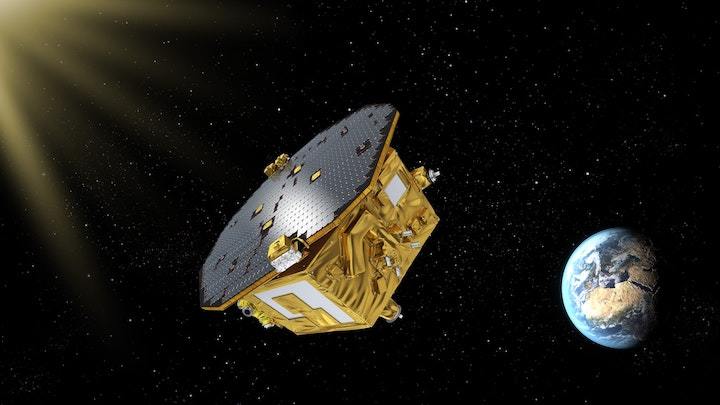
The European Space Agency (ESA) reports that it has created the “quietest place in space” as part of its plan to escape the Earth-bound obstacles that reduce its ability to detect gravitational waves.
In a paper published in the journal Physical Review Letters, ESA researchers led by Michele Armano of the University of Trento, Italy, report the final results of the LISA Pathfinder mission – a 400-million-euro experiment that kicked off in December 2015.
“LISA” stands for Laser Interferometer Space Antenna. The mission involved constructing a purpose-built spaceship – essentially an unmanned laboratory – and using it conduct an experiment that carried echoes of Galileo’s Leaning Tower of Pisa experiment.
The LISA Pathfinder mission wound up on July 18, 2017, but the analysis of the data gained has only just been completed.
With the researchers claiming success, the door is now open – theoretically, at least – for ESA’s most ambitious mission yet. This will be a full-scale LISA set up, comprising three satellites arrayed in a triangular formation, 2.5 million kilometres apart and linked by laser beams. The satellites will be geared to detecting the minuscule distortions created by gravitational waves.
The LISA mission is slated for launch in 2034, although the ESA boffins happily admit that its demands outstrip the limits of present technology.
The reason for using a massive space-based detection facility is because Earth-based gravitational wave detectors – such as the Laser Interferometer Gravitational-Wave Observatory (LIGO) – are unable to completely escape interference from terrestrial noise sources, such as seismic activity. They also, of course, have a size limit: the two “arms” of LIGO are each four kilometres long – but that pales in comparison to LISA’s planed 2.5 million kilometre span.
Existing Earth-based detectors have been spectacularly successful in picking up gravitational waves produced as a result of colliding black holes or neutron stars.
However, they are geared to picking up signals within a comparatively narrow high frequency range – from 10 to 1000 hertz. That means they cannot pick up the gravitational waves produced by supermassive black holes, which are predicted to be in the range of 0.00002 to 0.1 hertz, much less the waves that form part of the cosmological background (generated 13.8 billion years ago), which are predicted to have frequencies as low as 0.000000000000001 hertz.
To have a chance of detecting these, equipment must operate in an environment that is exquisitely silent – and this is where the LISA Pathfinder mission comes in, as proof-of-concept that measuring equipment can be completely isolated from all noise, even that created by molecules banging into each other.
The Pathfinder craft contained a void space in which were located two two-kilogram free-falling cubes, linked by lasers. The craft itself, once in orbit, was controlled by minuscule micro-newton thrusters that angled the ship this way and that, shielding the void from interference created by the pressure of solar radiation and particles propelled by solar wind.
Inside, progressive adjustments to onboard equipment allowed the researchers to concentrate on sensing frequencies below one hertz. One challenge involved dealing with the effect of residual escaping gas inside the craft, which caused molecules to bounce off the cubes. It took several months, but eventually the effect was reduced 10-fold.
Also greatly reduced was the tiny inertial force acting on the cubes, produced by a combination of the Pathfinder’s orbit and the trackers used to orient it.
In the final paper, the researchers report that by the end of the mission, LISA Pathfinder was able to detect noises down to an astonishing 0.00002 hertz – well within the range required for the full-scale LISA mission.
This means that once the triangle of satellites is eventually up and running, it will be able to detect very early signs of a black hole merger, weeks before the eventual collision.
Quelle: COSMOS
---
Update: 14.02.2018
.
LISA pathfinder mission a glorious success
LISA pathfinder three times better than required, 10 times better than expected.
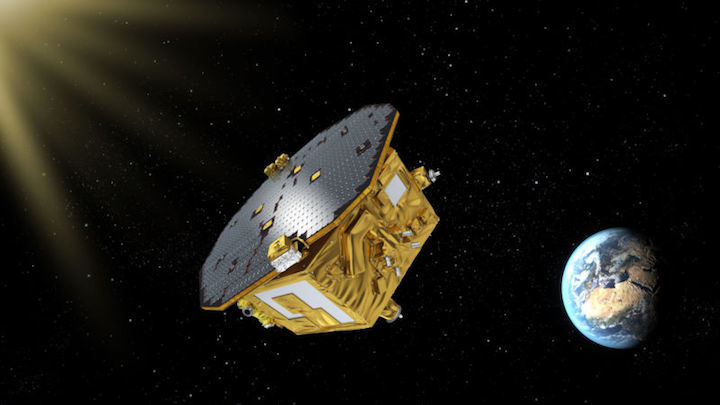
Even before the first gravitational waves were observed, plans were in place for the generation that would follow the successful LIGO detectors. The new hardware is expected to operate in space and sense gravitational waves that we have little to no chance of detecting using Earth-based observatories.
Of course, no one wants to launch a very expensive system into space without some assurance that it will work. Hence, the ESA developed a pathfinder mission that tests the technology. The latest report from the pathfinder mission is not just positive, it is what-did-I-just-snort positive.
Illuminating stretchy space
Gravitational waves are detected by sensing very tiny shifts in the distance between two mirrors, which change as a gravitational wave passes through, and the very fabric of spacetime stretches and contracts. If we can count the number of wavelengths that fit between two mirrors, we can sense the change in distance. LIGO (laser interferometer gravitational wave observatory), for instance, uses this approach to spot changes of about 10-19 meters between mirrors that are separated by four kilometers.
That sensitivity would be improved if the distance were greater. On Earth, though, the distance we can build in a straight line is limited. And, even worse, what scientists really want is sensitivity to low-frequency gravitational waves, which requires long distances and a quiet environment. Our planet is not especially quiet.
In the first gravitational-wave detection—a merger between two black holes—the signal came out of the noise and reached a peak within about half a second before disappearing. Over that time, gravitational waves with frequencies between 30 and 300Hz were detected. That frequency corresponds to the orbital period of the black holes. So, we detected this death spiral once the black holes were orbiting each other 30 odd times per second.
That pre-merger spiral had been going on for much longer than that, emitting gravitational waves with much lower frequencies. If we ever want to see these, we have to have detectors that are sensitive to waves that have a much longer wavelength. And that simply isn't possible on Earth.
It is, however, possible in space, and that is where LISA (laser interferometer space antenna) comes in. LISA is, as the name suggests, a space-based gravitational-wave observatory. However, unlike LIGO, which could be built and incrementally improved, LISA has to work the first time.
Blazing a trail for LISA
To maximize the chance of a functional space-based gravitational-wave observatory, the European Space Agency launched the LISA pathfinder, a satellite that is designed to test key technologies required for LISA. In particular, LISA requires measuring tiny accelerations of test masses. However, these masses are sitting in the noisy environment of a spacecraft, which heats and cools and sporadically gets smacked by little rocks. One of the main mission objectives was to see just how much noise there was and what sort of technology LISA would require to operate successfully.
It must be said that the goals for the pathfinder mission were comparatively modest. LISA must be able to measure accelerations as small as three femtometers/s2 (a fm is 10-15m) at a frequency just above a millihertz. Pathfinder was expected to do no better than around 20fm/s2, just to demonstrate that the hardware was on the right track. The engineers must have partied hard into the night when they found that the pathfinder has been (and may still be) nearly at the sensitivities required for LISA—only off by a factor of two.
But the team wasn't done there. After recovering from the hangover, the scientists returned to their data to try to understand where the rest of the noise was coming from. In their analysis, they uncovered something very odd: a systematic error that added pseudo-random noise. Normally, a systematic error is something like a constant offset—my instrument always reports 1 m/s2 more acceleration than is actually present.
But it turned out that a processing error between an analog signal and its digitization, though systematic in nature, generated an effectively random noise in the acceleration data. Once removed, the noise improved substantially.
This improvement was not the only one that turned up. The researchers also noticed that the signal steadily got cleaner with time. This steady improvement was found to be due to reduced Brownian motion.
Vacuum cleaning
This is due to how the experiment was configured. Once the spacecraft achieved orbit, test masses were suspended in the vacuum of space inside the satellite, which protected them from temperature changes and being struck by passing material. Normally, space is the best vacuum achievable and far better than the best Earth-based vacuum systems.
But the surrounding satellite turned out to be a problem. All the volatile materials in the wiring and electronics, as well as water attached to the metal walls, slowly boil off over time. As a result, the vacuum close to the masses is actually pretty poor (about two to three orders of magnitude worse than a good Earth-based vacuum system). These residual gases collide with the mass, accelerating it in random directions and generating noise. This is classic Brownian motion.
Over time, however, the volatile elements, like water, slowly escape into space. As the vacuum improved, the noise induced by Brownian motion decreased steadily.
The researchers were also able to use longer datasets to better compensate for the spacecraft's rotation. The pathfinder satellite uses certain stars to determine its orientation and rotation, but that's limited by how accurately the optics can determine the center of each star. By using data acquired over longer time periods, repeated observations of the stars were used to pinpoint the star's center more accurately.
The end result of all this is that the Pathfinder satellite—which was only supposed to perform an order of magnitude worse than required for LISA—actually performs a factor of three better than required for LISA.
The engineers are probably on another bender right now.
A flatulent satellite?
All is not rosy, however. The longer datasets for averaging were acquired by removing glitches. Mathematically, the glitches are quite separate from the expected data and can be removed. But this is highly undesirable, as any gravitational wave that has the same timescale as a glitch would, at present, also be removed.
To make matters worse, no one really knows why these glitches occur. The current best suggestion is the boiling off of volatiles. One idea is that, instead of providing a steady stream of gas, sometimes the gas is trapped in a pocket that suddenly bubbles out and farts on the masses. A calculation of the required amount of gas per glitch indicates that this is not an unreasonable suggestion. Nevertheless, the data also suggests that thorough degassing is going to be critical for LISA.
This is, I think, surprising. I would expect that all the components for pathfinder were degassed about as well as possible already. In that respect, I think there will be a search for new materials that release their volatile gases smoothly and silently.
In the meantime, LISA has already been approved, and the lessons learnt from Pathfinder are probably being incorporated into the final LISA satellite designs. I look forward to finally getting to hear the Universe's astrophysical symphony (preferably without fart noises).
Quelle: arsTechnica
----
Update: 26.04.2022
.
Upcoming satellite mission may 'see' how early universe cooled
Airbus to further develop LISA gravitational wave observatory mission
Launch of three-spacecraft constellation planned for late 2030s 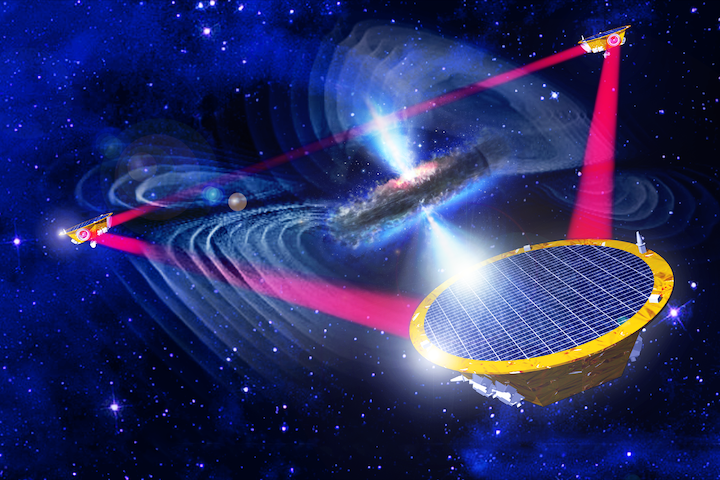
Friedrichshafen, 19 May 2022 - Airbus has been awarded a contract from the European Space Agency (ESA) to further develop the implementation of LISA (Laser Interferometer Space Antenna), one of the most ambitious science missions ESA has planned to date. With Phase B1 now underway, the detailed mission design and final technology development activities for the gravitational wave observatory are due to be completed by 2024, with launch planned for the late 2030s.
Gravitational waves were first postulated by Albert Einstein. They are distortions in space-time, created when for example supermassive black holes - billions of times heavier than our sun - merge. These events are so powerful that the resulting gravitational waves can be measured by sensitive instruments from billions of light years away.
To measure these waves, LISA consists of three spacecraft that form an equilateral triangle deep in space, 2.5 million kilometres apart from each other. Gravitational waves stretch and compress space-time, causing the tiniest changes in distance between the LISA probes (less than the diameter of an atom). Any movements of test masses that free-fall inside the three spacecraft when a gravitational wave passes can be detected by the spacecrafts’ sensitive instruments. LISA will do this by using lasers that continuously transmit back and forth between the satellites using interferometry, measuring the distance between each of the test masses.
Some of the key technologies required for LISA were successfully tested in space with the LISA Pathfinder (LPF) mission developed and built by Airbus as prime. The mission results showed that LPF operated even more precisely than required for LISA. LPF was launched on 3rd December 2015 and ended in July 2017.
Gravitational waves are a new research method that uses gravity instead of light to measure dynamic processes in the universe. The study of gravitational waves offers enormous potential for discovering parts of the universe that are invisible in other ways. LISA will significantly expand our knowledge of the beginning, evolution, and structure of our universe. Gravitational waves have been detected by ground-based observatories in recent years – by experiments such as LIGO and the European Virgo observatory – but these facilities are limited in size and sensitivity, meaning that they are only able to detect high-frequency gravitational waves from particular sources (such as merging stellar-mass black holes and neutron stars). Quelle: AIRBUS
----
Update: 27.01.2024
.
NASA Collaborating on European-led Gravitational Wave Observatory in Space
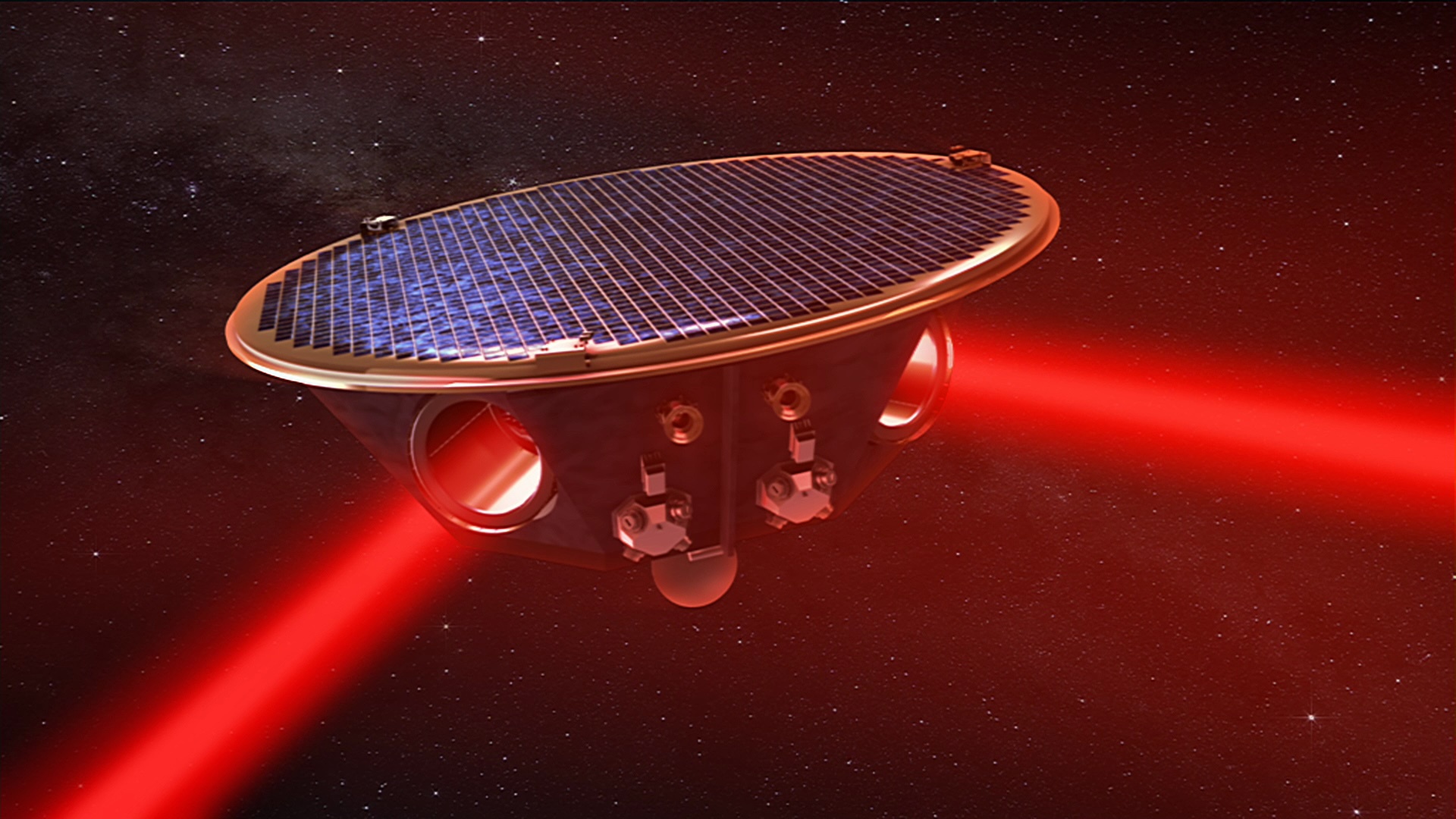
“In 2015, the ground-based LIGO observatory cracked open the window into gravitational waves, disturbances that sweep across space-time, the fabric of our universe,” said Mark Clampin, director of the Astrophysics Division at NASA Headquarters in Washington. “LISA will give us a panoramic view, allowing us to observe a broad range of sources both within our galaxy and far, far beyond it. We’re proud to be part of this international effort to open new avenues to explore the secrets of the universe.”
NASA will provide several key components of LISA’s instrument suite along with science and engineering support. NASA contributions include lasers, telescopes, and devices to reduce disturbances from electromagnetic charges. LISA will use this equipment as it measures precise distance changes, caused by gravitational waves, over millions of miles in space. ESA will provide the spacecraft and oversee the international team during the development and operation of the mission.
Gravitational waves were predicted by Albert Einstein’s general theory of relativity more than a century ago. They are produced by accelerating masses, such as a pair of orbiting black holes. Because these waves remove orbital energy, the distance between the objects gradually shrinks over millions of years, and they ultimately merge.
These ripples in the fabric of space went undetected until 2015, when LIGO, the Laser Interferometer Gravitational-Wave Observatory, funded by the U.S. National Science Foundation, measured gravitational waves from the merger of two black holes. This discovery furthered a new field of science called “multimessenger astronomy” in which gravitational waves could be used in conjunction with the other cosmic “messengers” – light and particles – to observe the universe in new ways.
Along with other ground-based facilities, LIGO has since observed dozens more black hole mergers, as well as mergers of neutron stars and neutron star-black hole systems. So far, the black holes detected through gravitational waves have been relatively small, with masses of tens to perhaps a hundred times that of our Sun. But scientists think that mergers of much more massive black holes were common when the universe was young, and only a space-based observatory could be sensitive to gravitational waves from them.
“LISA is designed to sense low-frequency gravitational waves that instruments on Earth cannot detect,” said Ira Thorpe, the NASA study scientist for the mission at the agency’s Goddard Space Flight Center in Greenbelt, Maryland. “These sources encompass tens of thousands of small binary systems in our own galaxy, as well as massive black holes merging as galaxies collided in the early universe.”
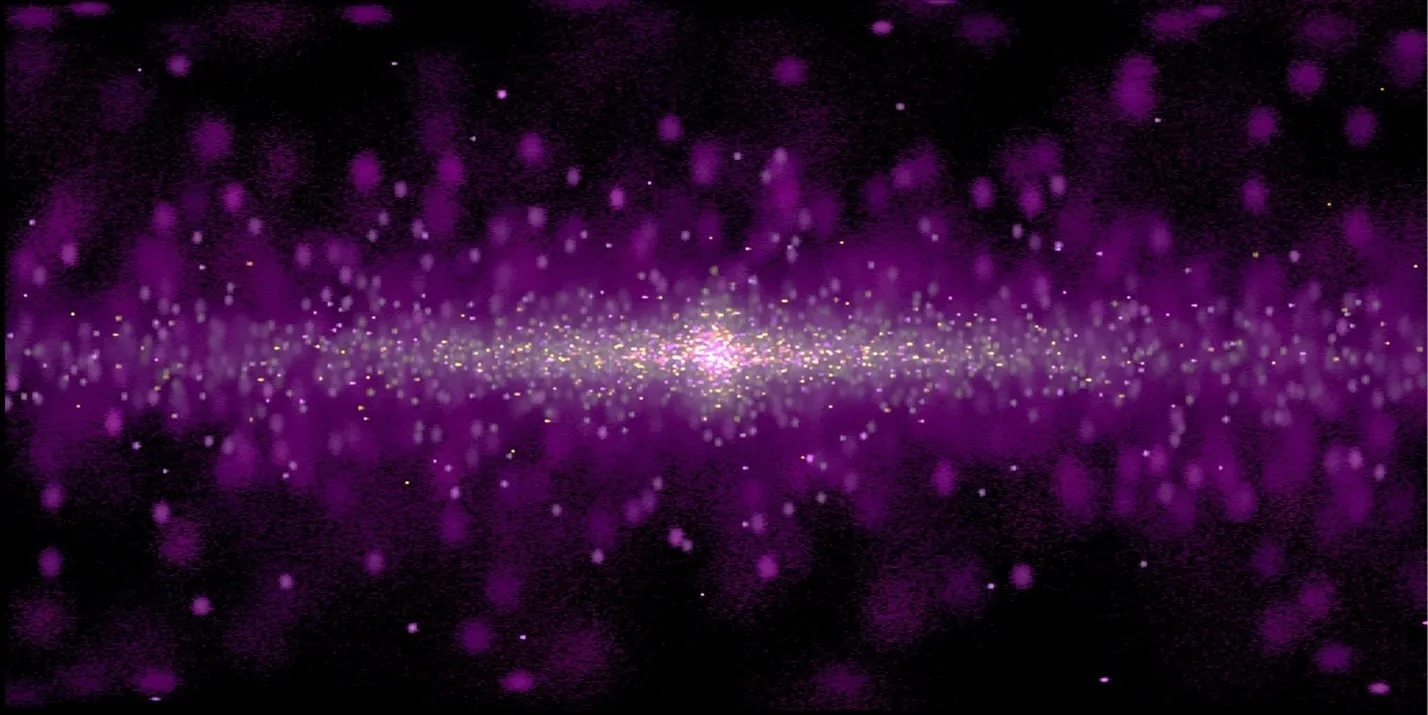
LISA will consist of three spacecraft flying in a vast triangular formation that follows Earth in its orbit around the Sun. Each arm of the triangle stretches 1.6 million miles (2.5 million kilometers). The spacecraft will track internal test masses affected only by gravity. At the same time, they’ll continuously fire lasers to measure their separations to within a span smaller than the size of a helium atom. Gravitational waves from sources throughout the universe will produce oscillations in the lengths of the triangle’s arms, and LISA will capture these changes.
The underlying measurement technology was successfully demonstrated in space with ESA’s LISA Pathfinder mission, which operated between 2015 and 2017 and also included NASA participation. The spacecraft demonstrated the exquisite control and precise laser measurements needed for LISA.
Capturing the ripples of spacetime: LISA gets go-ahead
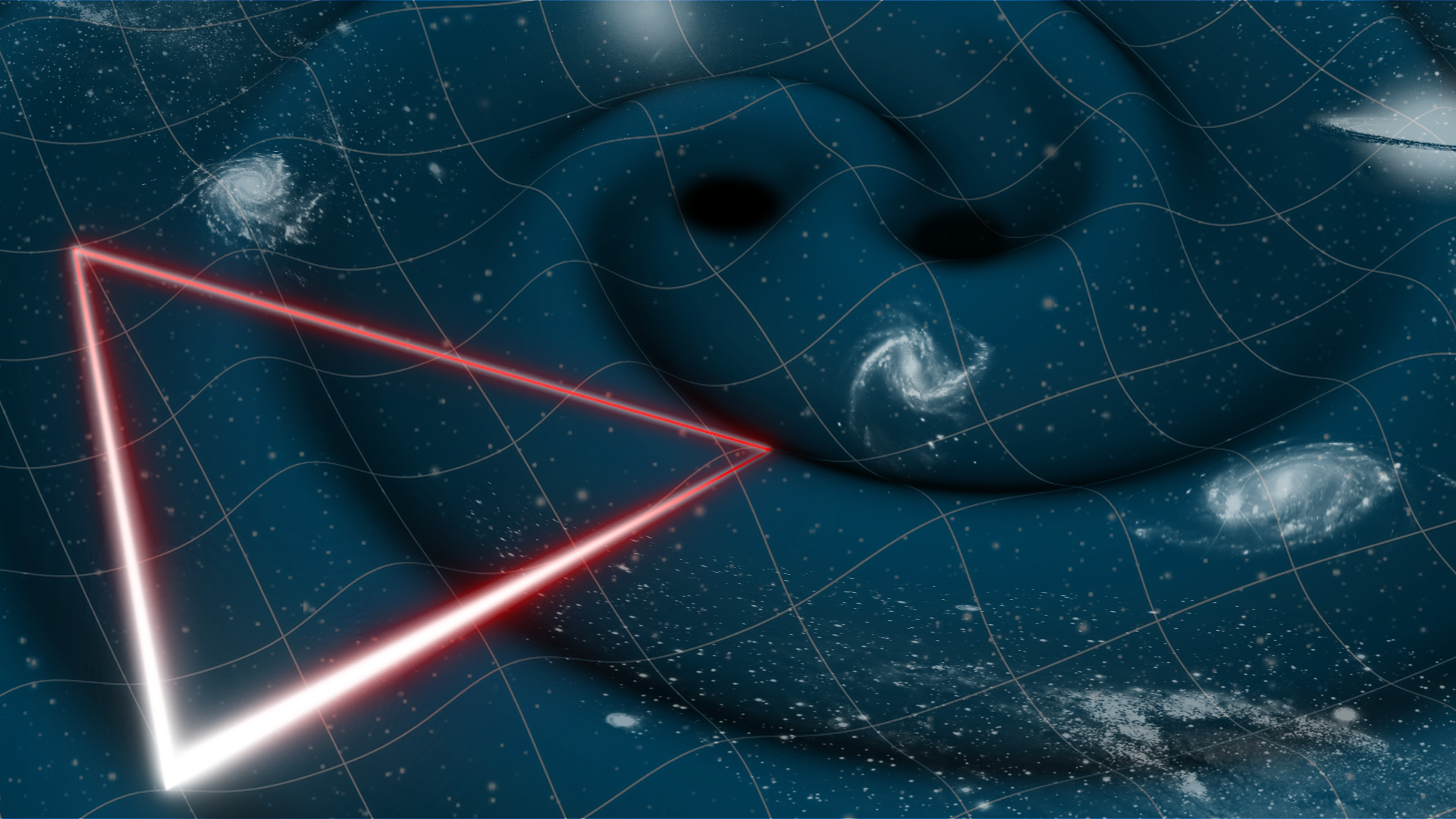
Today, ESA’s Science Programme Committee approved the Laser Interferometer Space Antenna (LISA) mission, the first scientific endeavour to detect and study gravitational waves from space.
This important step, formally called ‘adoption’, recognises that the mission concept and technology are sufficiently advanced, and gives the go-ahead to build the instruments and spacecraft. This work will start in January 2025 once a European industrial contractor has been chosen.
LISA is not just one spacecraft but a constellation of three. They will trail Earth in its orbit around the Sun, forming an exquisitely accurate equilateral triangle in space. Each side of the triangle will be 2.5 million km long (more than six times the Earth-Moon distance), and the spacecraft will exchange laser beams over this distance. The launch of the three spacecraft is planned for 2035, on an Ariane 6 rocket.
Led by ESA, LISA is made possible by a collaboration between ESA, its Member State space agencies, NASA, and an international consortium of scientists (the LISA consortium).
Bringing ‘sound’ to the cosmic movie
Just over a century ago, Einstein made the revolutionary prediction that when massive objects accelerate, they shake the fabric of spacetime, producing miniscule ripples known as gravitational waves. Thanks to modern technological developments, we are now able to detect these most elusive of signals.
“LISA is an endeavour that has never been tried before. Using laser beams over distances of several kilometres, ground-based instrumentation can detect gravitational waves coming from events involving star-sized objects – such as supernova explosions or merging of hyper-dense stars and stellar-mass black holes. To expand the frontier of gravitational studies we must go to space,” explains LISA lead project scientist Nora Lützgendorf.
“Thanks to the huge distance travelled by the laser signals on LISA, and the superb stability of its instrumentation, we will probe gravitational waves of lower frequencies than is possible on Earth, uncovering events of a different scale, all the way back to the dawn of time.”
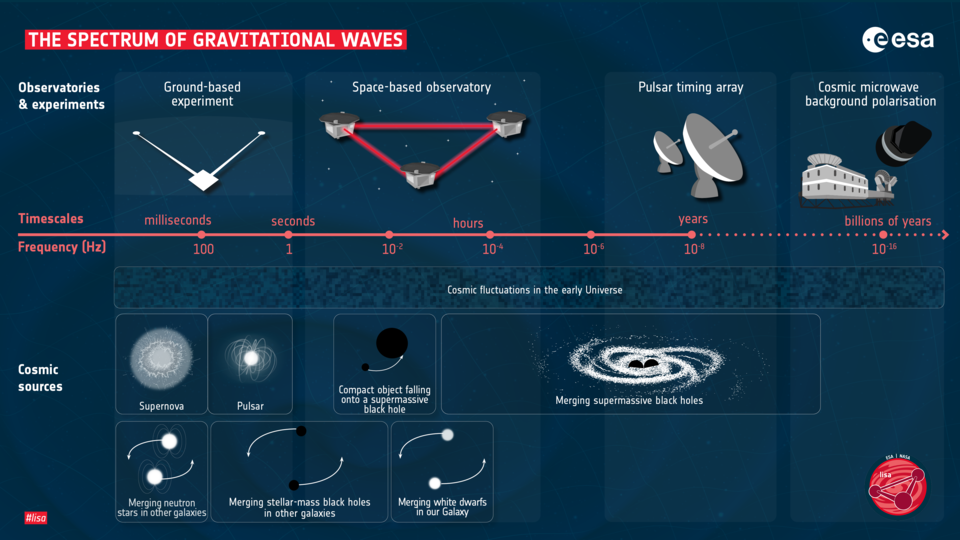
LISA will detect, across the entire Universe, the ripples in spacetime caused when huge black holes at the centres of galaxies collide. This will enable scientists to trace the origin of these monstrous objects, to chart how they grow to be millions of times more massive than the Sun and to establish the role they play in the evolution of galaxies.
The mission is poised to capture the predicted gravitational ‘ringing’ from the initial moments of our Universe and offer a direct glimpse into the very first seconds after the Big Bang. Additionally, because gravitational waves carry information on the distance of the objects that emitted them, LISA will help researchers measure the change in the expansion of the Universe with a different type of yardstick from the techniques used by Euclid and other surveys, validating their results.
Closer to home, in our own galaxy, LISA will detect many merging pairs of compact objects like white dwarfs or neutron stars and give us a unique insight into the final stages of the evolution of these systems. By pinpointing their position and distances, LISA will further our grasp of the structure of the Milky Way, building upon the findings from ESA's Gaia mission.
“For centuries we have been studying our cosmos through capturing light. Coupling this with the detection of gravitational waves is bringing a totally new dimension to our perception of the Universe,” remarks LISA project scientist Oliver Jennrich.
“If we imagine that, so far, with our astrophysics missions, we have been watching the cosmos like a silent movie, capturing the ripples of spacetime with LISA will be a real game-changer, like when sound was added to motion pictures.”
Golden cubes and laser beams

To detect gravitational waves, LISA will use pairs of solid gold-platinum cubes – so called test masses (slightly smaller than Rubik’s cubes), free-floating in special housing at the heart of each spacecraft. Gravitational waves will cause tiny changes in the distances between the masses in the different spacecraft, and the mission will track these variations using laser interferometry.
This technique requires shooting laser beams from one spacecraft to the other and then superimposing their signal to determine changes in the masses’ distances down to a few billionths of a millimetre.
The spacecraft must be designed to ensure that nothing, besides the geometry of spacetime itself, affects the movement of the masses, which are in freefall.
Solid heritage and future teamwork
The spacecraft follows in the footsteps of LISA Pathfinder, which demonstrated that it is possible to keep the test masses in freefall to an astonishing level of precision. The same precision propulsion system that has also been flown on ESA’s Gaia and Euclid missions will ensure that each spacecraft maintains the required position and orientation with the highest accuracy.
Selected to be the third large mission of ESA’s Cosmic Vision 2015–2025, LISA will join ESA’s science fleet of cosmic observers to address two essential questions at the heart of the programme: What are the fundamental physical laws of the Universe? How did the Universe originate and what is it made of?
In this quest, LISA will work together with ESA’s other large mission currently under study: NewAthena. With a launch date foreseen for 2037, NewAthena is set to be the largest X-ray observatory ever built.
Notes for editors
ESA leads the LISA mission and will provide the spacecraft, launch, mission operations and data handling. Key instrumental elements are the free-falling test masses shielded from external forces, provided by Italy and Switzerland; the picometre-accuracy systems to detect the interferometric signal, provided by Germany, the UK, France, the Netherlands, Belgium, Poland and the Czech Republic; and the Science Diagnostics Subsystem (an arsenal of sensors across the spacecraft), provided by Spain. The ultra-stable lasers, the 30 cm telescopes to collect their light, and the sources of UV light (to discharge the test masses) will be provided by NASA.
Quelle: ESA


